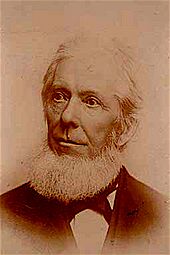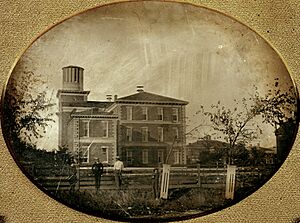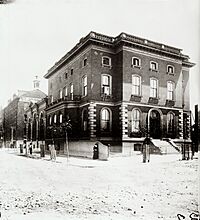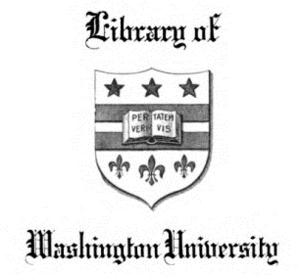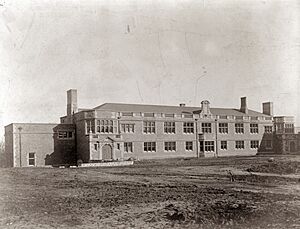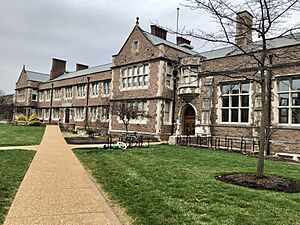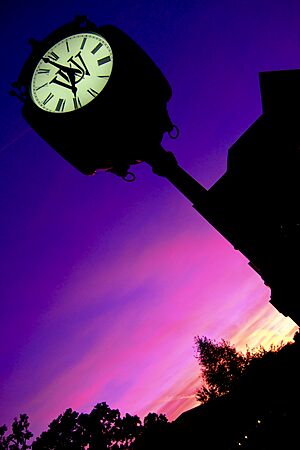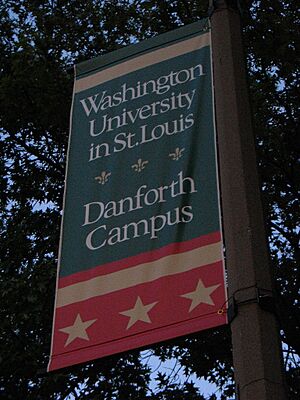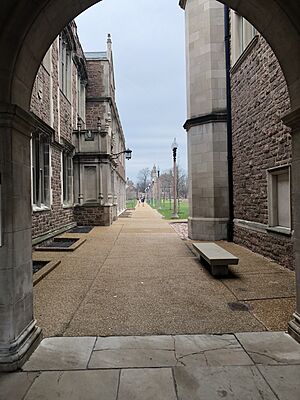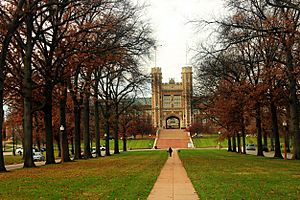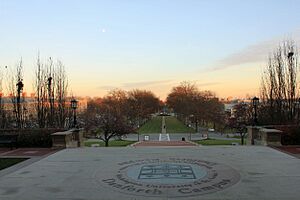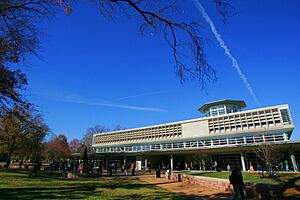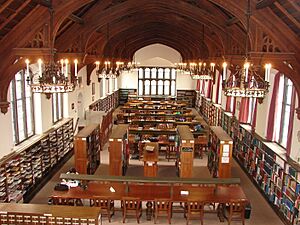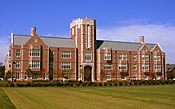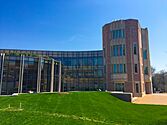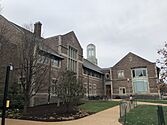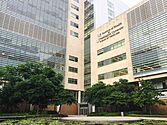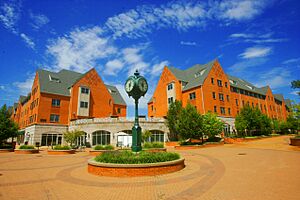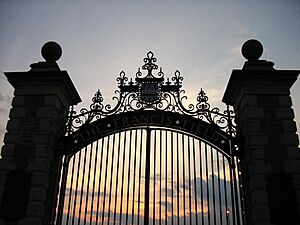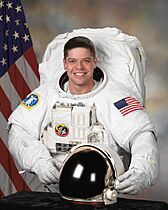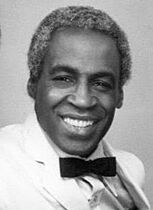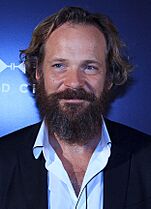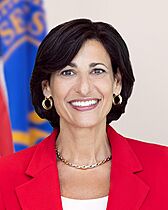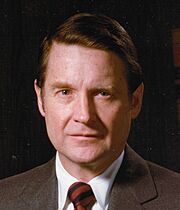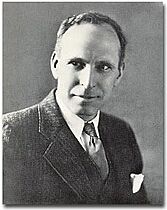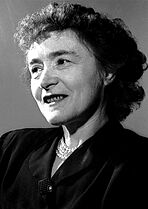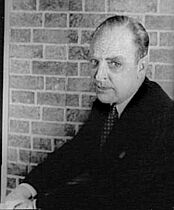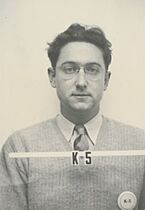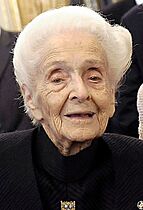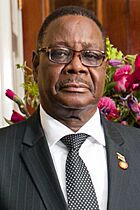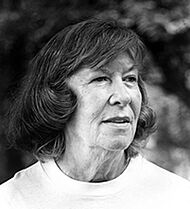Washington University in St. Louis facts for kids
 |
|
|
Former name
|
|
|---|---|
| Motto | Per veritatem vis (Latin) |
|
Motto in English
|
"Strength through truth" |
| Type | Private research university |
| Established | February 22, 1853 |
| Accreditation | HLC |
|
Academic affiliations
|
|
| Endowment | $12.0 billion (FY24) |
| Chancellor | Andrew D. Martin |
| Provost | Beverly Wendland |
|
Academic staff
|
4,551 (2024) |
|
Administrative staff
|
17,979 (2024) |
| Students | 16,399 (fall 2024) |
| Undergraduates | 8,243 (fall 2024) |
| Postgraduates | 7,289 (fall 2024) |
| Location |
,
Missouri
,
United States
38°38′53″N 90°18′18″W / 38.648°N 90.305°W |
| Campus | Suburban, 355 acres (1.44 km2) |
| Newspaper | Student Life |
| Colors | Red and green |
| Nickname | Bears |
|
Sporting affiliations
|
|
| Mascot | Bear |
Washington University in St. Louis (often called WashU) is a private research university. It is located in St. Louis, Missouri, in the United States. The university was started in 1853 by local leaders. It was named after George Washington, the first U.S. president.
WashU has two main campuses: Danforth and Medical. Together, they cover 355 acres. The university has nine different schools. It offers many types of degrees. These include over 150 programs for undergraduate students. There are also 80 master's and professional programs. Plus, there are 50 doctoral degree programs.
In 2024, WashU had 16,399 students. These students came from all 50 U.S. states. They also came from more than 110 countries around the world.
The university was founded because there weren't enough colleges in the Midwest. Its first classes were held in 1854 in downtown St. Louis. In 1905, WashU moved to a new campus. This new location was northwest of Forest Park. This move allowed the university to grow and add new buildings.
WashU joined the Association of American Universities in 1923. For the class entering in fall 2024, the university received over 32,750 applications. It accepted about 12 percent of these students. WashU supports more than 400 student groups.
The university's sports teams are called the Washington University Bears. They compete in NCAA Division III. They are founding members of the University Athletic Association. They are also part of the College Conference of Illinois and Wisconsin. Their mascot is the Bear. The official colors are red and green. The Bears have won 26 national championships in Division III.
A group called the Board of Trustees guides the university. They make sure it meets its goals for education and finances. As of 2024, Andrew D. Martin is the Chancellor. Beverly Wendland is the Provost. The university's special fund, called an endowment, is $12.0 billion. This is one of the largest in the U.S.
WashU's motto is Per veritatem vis. This Latin phrase means "Strength through truth." The university is approved by the Higher Learning Commission. It has also hosted four presidential debates. It also hosted one vice-presidential debate.
Many famous people have been part of WashU. As of 2024, 26 Nobel laureates have been connected to the university. This includes former teachers or students. Also, 11 Pulitzer Prize winners have ties to WashU. Four U.S. Poets Laureate and six MacArthur Fellows are also connected. WashU is known for producing many Fulbright scholars. Its alumni also include 17 university presidents. There are also 21 members of the United States Congress. Plus, 30 Rhodes Scholars and 20 Truman Scholars are alumni.
Contents
WashU's Story
Starting the University
How WashU Began
Washington University was started in 1853. Seventeen leaders from St. Louis wanted more colleges in the Midwest. State Senator Wayman Crow and minister William Greenleaf Eliot led this effort. Crow helped get the university's official charter. Eliot became the first president of the board. Joseph Gibson Hoyt was the first chancellor.
WashU was different from many other colleges. It did not start with a lot of money. It also did not have support from a church or the government.
The university was first called Eliot Seminary. But Eliot himself did not like this name. He wanted the school to be open to everyone, not just one religion. So, the name was changed to Washington Institute. This honored George Washington. The charter was approved on his birthday, February 22. In 1856, the name officially became Washington University.
Early Growth and Changes
Even though it was called a university, it started as a night school. It had no buildings or full-time teachers at first. Classes began on October 22, 1854. They were held in a public school building. Tuition was free. By the end of the first year, 270 students had joined. They ranged in age from 8 to 46.
In 1856, WashU built its first building. It was located on Seventeenth Street in downtown St. Louis. The university stayed in downtown St. Louis for 50 years.
In 1856, a special department for boys was created. Boys aged ten and older could join after passing an exam. In 1859, a similar department for girls was started. This was named Mary Institute, honoring Eliot's daughter. The boys' department was later named Smith Academy in 1879.
WashU's law school was the first part of the university to accept women. This happened in 1869. Lemma Barkeloo and Phoebe Couzins were the first women to enroll. Couzins earned her law degree in 1871. Women were regularly admitted to the law school again starting in 1886.
In 1871, Eliot became the third chancellor.
In 1879, the St. Louis Manual Training School opened. It was part of Washington University. This was the first school of its kind in the U.S. Students spent equal time on hands-on training and schoolwork.
In the 1870s, fewer students were joining the university. So, WashU made it easier for high school graduates to get in. They could enter with a certificate instead of an exam. The university also added new types of degrees. Admitting women helped student numbers grow a lot. By the 1890s, women were a main reason for the college's growth.
Student groups at WashU often started and stopped. Sports teams like baseball and rowing formed and then broke up. But things changed in 1890. The Washington University Athletic Association started supporting intercollegiate football.
By 1892, WashU had changed its course requirements. Students had more choices in what they studied. This led to many new courses being offered.
Moving to a New Campus
St. Louis was growing fast. It was hard to find good land for a new campus. So, WashU decided to buy land for a new location. This land was bought in 1885. It cost $185,000. The university hired Olmsted, Olmsted & Eliot to design the new campus. They started with plans in 1895.
In 1897, WashU announced it would move its main campus. The new site was northwest of Forest Park. The architects loved the spot. They suggested buying more land, which happened in 1899. They also advised making the buildings look beautiful. Their plans included grouping buildings around open spaces.
Medical School Joins WashU
In 1890, the St. Louis Medical College wanted to work with WashU. They wanted to create a lab together. WashU first said no. But the medical college tried again. In 1891, they officially became the "Medical Department of Washington University."
In 1892, the Missouri Dental College also joined WashU. Its classes were similar to the medical college.
In 1899, the Missouri Medical College merged with the St. Louis Medical College. This made WashU's health programs stronger. The merger doubled the number of medical students. It also gave students more access to hospitals for learning.
University Seal and Motto
In 1896, Professor Holmes Smith designed the university seal. It uses parts of the Washington family coat of arms. It also has an open book, which stands for a university. A symbol for Louis IX, for whom St. Louis is named, is also included. In 1915, the university chose its motto: Per veritatem vis. This means "Strength through truth."
The 1900s at WashU
New Buildings and Programs

The first building on the new Hilltop Campus was Busch Hall. Its cornerstone was laid on October 20, 1900. Other buildings like Brookings Hall, Ridgley, and Cupples were built soon after.
WashU delayed using these buildings until 1905. This was to host the 1904 World's Fair and the 1904 Summer Olympics. Robert S. Brookings, a university leader, rented the first five buildings to the Fair. The $750,000 earned from this rent helped build four more buildings. These were also used by the Fair.
By 1905, the number of courses offered had tripled. In 1909, the college changed its curriculum. Students had to take a variety of courses. There were also limits on how much they could focus on one subject.
The School of Medicine partnered with Barnes Hospital in 1911. It also partnered with St. Louis Children's Hospital in 1912. These agreements meant that hospital staff were also university teachers. This gave the university access to patients for teaching and research. In return, WashU built new medical facilities next to the hospitals. In 1915, a new medical complex was finished. Three years later, the first women enrolled as medical students.
In 1922, Arthur Holly Compton worked in the basement of Eads Hall. He showed that light acts like particles. This discovery is called the "Compton Effect." He won the Nobel Prize in Physics in 1927 for this work.
In 1923, Washington University joined the Association of American Universities.
Working for Fairness and Change
In 1945, four African American students were not allowed into WashU's summer school. This led to a lawsuit. The lawsuit argued that the university's policies were unfair. Even though the lawsuit did not win, it made the university's leaders talk about fairness.
Compton returned to WashU in 1946 as the ninth chancellor. He brought back the football team. He also made sure sports were for amateurs, with no athletic scholarships. Under Compton, more students joined the university. Many were World War II veterans using the G.I. Bill. Student numbers grew a lot, reaching 13,204 by fall 1947.
Before the university leaders made a decision, some departments started making changes. In 1947, the medical school allowed an African American student into a special course. The School of Social Work also started admitting African American students in December 1947. The graduate school followed soon after.
In 1949, students formed a group called SCAN. They wanted to end unfair policies. They took a poll, and most students supported ending unfair policies. By the end of 1949, unfair tests for admission were removed for all graduate programs. The dentistry school followed in 1950. On May 9, 1952, unfair tests for undergraduate programs were also removed.
In 1958, plans for new student housing were approved. This area was called the South 40. It was named for its location and size (40 acres). This project added many dorms. With more on-campus housing, WashU started attracting students from all over the country. By 1964, over two-thirds of new students came from outside the St. Louis area.
Student Voices and Growth
In the late 1960s, Black students formed the Association of Black Collegians (ABC). This group supported Black students. They also worked to make the campus more fair and inclusive. In 1968, an incident with campus police led to a student protest. After talks, the university increased its efforts for diversity. It also created the department of African and African-American Studies.
In May 1970, students protested the U.S. actions in Cambodia. They also protested the Kent State shootings. A large group of students marched. Some damaged and set fire to a building. Firefighters put out the fire.
In 1971, William Henry Danforth became chancellor. During his 24 years, WashU became a world-famous university. He added many new teaching positions. He also built dozens of new buildings. The university's special fund grew to $1.72 billion. Student scholarships also tripled.
In 1976, the university added "in St. Louis" to its name. This helped people know which Washington University it was.
Developing and Expanding
In 1995, Mark S. Wrighton became the 14th chancellor. During his time, applications to WashU more than doubled. The university added over 190 new teaching positions. It also updated its Arts & Sciences courses. More than 30 new buildings were completed. The university's special fund grew by over $5 billion.
WashU in the 2000s
In 2005, WashU started the "McDonnell International Scholars Academy." This group connects research universities worldwide. They work together on big problems like disease and poverty. It started with 15 partner schools in Asia. By 2022, it had over 30 partners globally.
The Hilltop Campus was renamed the Danforth Campus in 2006. This honored former chancellor William H. Danforth.
In 2014, a study showed that many WashU students came from wealthy families. In response, the university promised to increase the number of students who receive Pell Grants. These grants help students from lower-income families pay for college. The goal was to reach 13 percent by 2020. WashU met this goal early. By 2022, 19.9 percent of undergraduate students were eligible for Pell Grants. This was a 300 percent increase since 2012.
In 2019, Andrew D. Martin became the 15th chancellor. He announced the "WashU Pledge." This program offers free tuition to students from Missouri and southern Illinois. Their families must earn $75,000 or less per year. Or they must qualify for Pell Grants. In 2021, the university launched a $1 billion plan called Gateway to Success. This plan helps students pay for college. It includes accepting students without looking at their financial needs. It also covers all their financial needs.
In 2024, Washington University bought the campus of Fontbonne University. Fontbonne University is closing in 2025.
Hosting Important Debates
As of 2024, Washington University has hosted five major political debates. It hosted four presidential debates. It also hosted one vice-presidential debate. These included debates in 1992, 2000, 2004, 2008, and 2016. A debate was planned for 1996 but was canceled.
How WashU Works
WashU is run by a group called the Board of Trustees. They choose their own members. Trustees serve four-year terms. They can be chosen again. The Board makes big decisions for the university. This includes choosing the chancellor. They also approve the budget and new programs.
From 1983 to 1987, a campaign raised over $630 million for WashU. Another campaign from 1998 to 2004 raised over $1.5 billion.
On June 1, 2019, Andrew D. Martin became the 15th chancellor. The Chancellor manages the university's daily work. They also lead new projects.
In 2020, Beverly Wendland became the Provost.
WashU is part of several important groups. These include the Association of American Universities. It is also approved by the Higher Learning Commission.
Money and Help for Students
As of June 30, 2024, WashU has a special fund of $12.0 billion. This makes it one of the top 15 universities in the U.S. for its endowment. The university's total value, including its campus, is $20.48 billion.
For the 2025–2026 school year, tuition is $68,240. The total cost to attend and live on campus is about $92,932. WashU accepts students without looking at their financial needs. It also meets 100 percent of the financial need for accepted students. This means they help students pay for everything they need. WashU does not offer athletic scholarships.
University Campuses
Danforth Campus
In 1899, the university held a contest to design a new campus. The firm Cope & Stewardson won. Their design was inspired by famous universities like Oxford and Cambridge. It used a style called Collegiate Gothic.
The Danforth Campus is 169 acres. It is next to Forest Park. It is also near the cities of Clayton and University City, Missouri. A large part of the Danforth Campus is a National Historic Landmark. This means it is a very important historical place.
Medical Campus
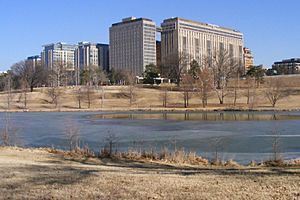
The Washington University Medical Center covers 186 acres. It is located in the Central West End neighborhood. This campus is home to the Washington University School of Medicine. It also includes its partners, Barnes-Jewish Hospital and St. Louis Children's Hospital.
In 2019, WashU received a $7.6 million grant. This was from the National Cancer Institute. It was to help improve cancer care in Missouri and Illinois. In 2022, WashU received a $61 million grant. This was to help advance new medical treatments. It also helps with fairness in health and diversity.
Learning at WashU
In 2023, WashU was chosen to join the Kessler Scholars Collaborative. This program helps students who are the first in their family to go to college. It also helps students who receive Pell Grants. The program aims to support students in STEM fields. It helps close the wealth gap by providing financial aid and opportunities.
Getting into WashU
For the class entering in fall 2024, WashU received over 32,750 applications. It accepted 12 percent of these students. Of those accepted, 86 percent were in the top 10 percent of their high school class. Also, 25 percent of enrolled students were eligible for Pell Grants. And 18 percent were the first in their family to go to college.
Students who submitted test scores usually scored very high. The middle 50 percent scored between 33 and 35 on the ACT. On the SAT, they scored between 1500 and 1570. These scores are much higher than the national averages. This means WashU students are among the top test-takers.
There are 7 students for every 1 teacher at WashU.
University Libraries
WashU has nine libraries. Olin Library is the main one. It holds over 5.3 million books. This makes it the 44th largest library in the U.S. It is part of the Association of Research Libraries. The other eight libraries include ones for business, medicine, and law.
WashU Libraries have special collections. These include rare books, old letters, and university records. They also have film archives.
WashU owns a rare copy of the Southwick Broadside. This is one of the few original printed copies of the Declaration of Independence. It was given to the university in 2015.
Rankings and Reputation
| ARWU World | 23 |
|---|---|
| THES World | 69 |
| USNWR National University | 21 (tie) |
| Washington Monthly National University | 23 |
| Forbes | 30 |
Washington University is ranked 21st in the U.S. by U.S. News & World Report for 2025. The Wall Street Journal ranks it 26th. In 2024, it was ranked 23rd in the world by the Academic Ranking of World Universities.
| Audiology | 8 |
| Biological Sciences | 15 |
| Business | 24 |
| Chemistry | 42 |
| Computer Science | 45 |
| Earth Sciences | 33 |
| Economics | 29 |
| Engineering | 43 |
| English | 26 |
| History | 36 |
| Law | 14 |
| Mathematics | 43 |
| Medicine | 5 |
| Occupational Therapy | 3 |
| Physical Therapy | 1 |
| Political Science | 13 |
| Psychology | 8 |
| Public Health | 22 |
| Social Work | 2 |
In 2025, Princeton Review ranked WashU number 1 for "Top Midwest Entrepreneurship: Ugrad." It was also number 2 for "Top Entrepreneurship Under Ten Thousand Students: Ugrad." QS World University Rankings ranked WashU 19th in the world for anatomy and physiology in 2025.
In 2025, Forbes included WashU in its "2025 New Ivies" list. This list highlights colleges that employers love. These schools are known for strong academics. Their graduates are highly sought after.
As of 2022, 19.9 percent of undergraduate students received Pell Grants. This is a big increase since 2012.
WashU is also listed in The Hidden Ivies. This guidebook describes schools that offer an Ivy League-level education. This means they have strong academics and a great campus experience.
WashU is a top school for students winning special scholarships. These include the Fulbright program, Harry S. Truman Scholarship, and Rhodes Scholarship.
Research and Discoveries
| College/School | Year founded |
| College of Arts & Sciences | 1853 |
| James McKelvey School of Engineering | 1854 |
| School of Law | 1867 |
| College of Art | 1879 |
| School of Medicine | 1891 |
| College of Architecture | 1910 |
| Olin Business School | 1917 |
| Graduate School of Arts & Sciences | 1922 |
| George Warren Brown School of Social Work | 1925 |
| School of Continuing & Professional Studies | 1931 |
| Sam Fox School of Design & Visual Arts | 2005 |
WashU is known as an R1 university. This means it does "Very High Research." It also produces many doctoral degrees. This classification helps show how much research a university does.
In fiscal year 2023, WashU ranked 27th in the U.S. for research spending. It spent $1.169 billion on research and development. This was an 11.7 percent increase from the year before. In 2022, WashU developed a nasal vaccine for COVID-19. This vaccine was approved for use in India. In 2025, WashU's vaccine was approved for clinical trials in the United States.
In 2019, the Washington University School of Medicine took over Folding@Home. This project uses the power of many home computers. Volunteers let their computers help simulate protein folding. This research helps study diseases like Alzheimer's, cancer, and Ebola. In 2020, the project reached an amazing speed. It was seven times faster than the world's top supercomputer.
The university also hosts NASA's Planetary Data System Geosciences Node. This supports missions to Mars. Professor Raymond Arvidson helps lead the Mars Exploration Rovers project.
WashU students have also worked on digitizing old writings. They digitized the works of a 16th-century poet, Edmund Spenser. This project is a big update to his collected works. It will include both print and digital versions.
Colleges and Schools
WashU offers many degree programs. There are over 150 for undergraduates. There are also 80 master's and professional programs. Plus, there are 50 doctoral degree programs.
- The College of Arts & Sciences is the largest undergraduate program. It offers over 50 subjects. These include anthropology, chemistry, and performing arts.
- The George Warren Brown School started in 1925. It was named after George Warren Brown. In 1948, it was the first school at WashU to admit Black students.
- The James McKelvey School of Engineering was renamed in 2019. It honors Jim McKelvey Jr., a co-founder of Square.
- The Olin Business School started in 1917. It was named after John M. Olin. In 2002, it started a special business program in Shanghai.
- The Sam Fox School of Design & Visual Arts began in 2006. It brought together art, architecture, and the university's museum. It was the first art museum west of the Mississippi River. Steinberg Hall, built in 1960, was designed by a famous architect, Fumihiko Maki.
- The School of Continuing & Professional Studies (CAPS) started in June 2023. It focuses on adult learners. It helps them get jobs in growing fields. These include data analytics and healthcare.
- The Washington University School of Law started in 1867. It is the oldest law school west of the Mississippi River. It offers joint degree programs with other schools.
- The Washington University School of Medicine started in 1891. In 2024, it ranked second in the U.S. for government research funding.
Student Life
Student Body
| Race and ethnicity | Total | ||
|---|---|---|---|
| White | 44% |
|
|
| Asian | 20% |
|
|
| Hispanic | 12% |
|
|
| Black | 9% |
|
|
| Other | 8% |
|
|
| Foreign national | 7% |
|
|
| Economic diversity | |||
| Low-income | 16% |
|
|
In 2024, WashU had 16,399 students. They came from all 50 U.S. states. They also came from over 110 countries. This included 8,243 undergraduate students. There were also 7,289 graduate students.
Of the new students in fall 2024, 37 percent were Caucasian. 26 percent were Asian. 12 percent were Latino/Hispanic. 8 percent were Black/African-American. 11 percent were international students. 5 percent did not identify their background. 53 percent were female and 47 percent were male.
Student Groups
WashU has over 400 student groups. Most get money from the Washington University Student Union. In fiscal year 2024, the Student Union had a budget of $4.2 million. The Student Union helps with big campus events. It also gives out free newspapers like The New York Times.
WashU has 26 recognized fraternities and sororities. In 2020, many students left these groups. This was due to student concerns about fairness on campus. Some groups even closed. Students continue to ask for these groups to be removed from campus.
Where Students Live
The South 40 is the main housing area for first- and second-year students. It has 10 residential colleges and 23 dorms. It is named for being south of the Danforth Campus and its 40-acre size. It has a large dining hall called Bear's Den. It also has shops, a health center, and sports fields.
The Village is for third-year students and beyond. It has two buildings with suite-style rooms.
Student Media
WashU has seven student-run media groups. These include The Hatchet and Student Life. Student Life is a newspaper that started in 1878. KWUR (90.3 FM) is the student radio station. In 2003, KWUR was named the Best Radio Station in St. Louis. WUTV is the university's TV channel. It started in 1976.
Getting Around
Since 2006, WashU has offered free MetroLink passes. MetroLink is St. Louis’s train system. All full-time students and staff can use it. The Blue Line and Red Line trains stop on the Danforth Campus. The Red Line goes to the airport. The Blue Line goes to nearby suburbs. Both lines go to downtown St. Louis.
The WashU shuttle system offers free rides around campus. It also has routes to nearby neighborhoods. In 2025, a new Shopper Shuttle started. It takes students to shopping malls and stores like Target and Walmart.
Campus Traditions
Every semester, WashU hosts WILD. This is a concert in the Quad with popular music acts. Other traditions include Thurtene Carnival, a student-run carnival. There's also Vertigo, a dance party. The Residential Community Olympics is a yearly sports competition. Students also use the Underpass panels. These are displays under the tunnel connecting the South 40 to the main campus. They advertise events.
There's a fun belief among students. If you step on the university seal at Brookings Hall, you might not graduate on time!
WashU Sports
Washington University was a founding member of the University Athletic Association in NCAA Division III. It is also a member of the College Conference of Illinois and Wisconsin.
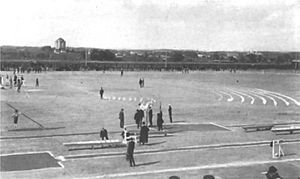
The WashU Bears have won 26 national championships in NCAA Division III. They have won 10 in volleyball. They also won 5 in women's basketball. They have won 2 in men's basketball. They also won 2 in women's cross country. Plus, 2 in women's outdoor track and field. They won 2 in women's soccer. They also won 1 in men's tennis. They won 1 in women's indoor track and field. And 1 in men's indoor track and field. The Bears have also won 267 conference titles. Their mascot is the Bear. Their official colors are red and green.
WashU also has over 40 club sports.
Francis Olympic Field
Francis Olympic Field is where WashU's football, soccer, and track teams play. It was a venue for the 1904 Summer Olympics. These were the first Olympic Games held outside of Europe. In 2019, the stadium was renamed Francis Olympic Field. This honors its Olympic history. The Olympic flame has passed through the field three times. This happened during torch relays for the 1984, 1996, and 2004 Summer Olympics.
Famous People from WashU
Washington University has over 166,000 living alumni. As of 2024, it has 22,530 employees. This includes 4,551 teachers and 17,979 staff members.
As of 2024, 26 Nobel laureates have been connected to WashU. This includes former teachers or students. Also, 11 Pulitzer Prize winners have ties to WashU. Four U.S. Poets Laureate and six MacArthur Fellows are also connected. WashU alumni and faculty have won many other important awards.
WashU alumni also include 17 university presidents. There are also 21 members of the United States Congress. Plus, 30 Rhodes Scholars and 20 Truman Scholars are alumni.
Alumni
In science, famous alumni include Nobel winners like Earl Sutherland. Others are Edwin Krebs and Daniel Nathans. They all won for work in medicine. Other notable scientists include J. C. R. Licklider, who helped develop computing. Julian W. Hill discovered nylon. Clyde Cowan helped discover the neutrino. Bob Behnken is a NASA astronaut.
In politics and public service, alumni include William H. Webster. He is the only person to lead both the FBI and the CIA. Rochelle Walensky was the Director of the Centers for Disease Control and Prevention. Clark Clifford advised several U.S. presidents. Other alumni include former U.S. senators Jim Talent and Alan J. Dixon. Phoebe Couzins was the first female U.S. Marshal.
In business, alumni include Avram Glazer, who leads Manchester United. Jim McKelvey co-founded Square Inc. Arnold W. Donald is the CEO of Carnival Corporation. Charles Nagel founded the U.S. Chamber of Commerce.
In the arts, famous alumni include Harold Ramis (from Ghostbusters). Peter Sarsgaard is an award-winning actor. Robert Guillaume won an Emmy for Benson. He was also the voice of Rafiki in The Lion King. Dave Garroway was the first host of NBC’s Today. Steven Sater is a Tony and Grammy-winning writer. Literary figures include novelist Fannie Hurst and Hugo Award winner Dan Simmons.
In architecture, George Hellmuth, Gyo Obata, and George Kassabaum started HOK. It is one of the world’s largest architecture firms.
Leaders in higher education include Abram L. Sachar, who founded Brandeis University. Thomas Lamb Eliot founded Reed College. Alumni also include former presidents of many other universities.
Some notable people attended WashU but did not graduate. These include playwright Tennessee Williams. Actor Robert Culp also attended. Marilyn vos Savant, known for her high IQ, also studied there.
Faculty
Many famous people have taught at WashU. These include Roger Nash Baldwin, who helped start the American Civil Liberties Union. Gerty Cori was the first woman to win a Nobel Prize in Physiology/Medicine. Rita Levi-Montalcini also won a Nobel Prize. Peter Mutharika was the President of Malawi. William Inge won a Pulitzer Prize for drama. Mona Van Duyn was a Pulitzer Prize winner and the first woman U.S. Poet Laureate. Joseph W. Kennedy helped discover the element plutonium. Thomas Eagleton was a U.S. Senator from Missouri.
More About WashU
- Center for Social Development
- Central Institute for the Deaf
- Crow Observatory
- Tyson Research Center
- Washington University School of Dental Medicine
- Whitney R. Harris World Law Institute
See also
 In Spanish: Universidad Washington en San Luis para niños
In Spanish: Universidad Washington en San Luis para niños


